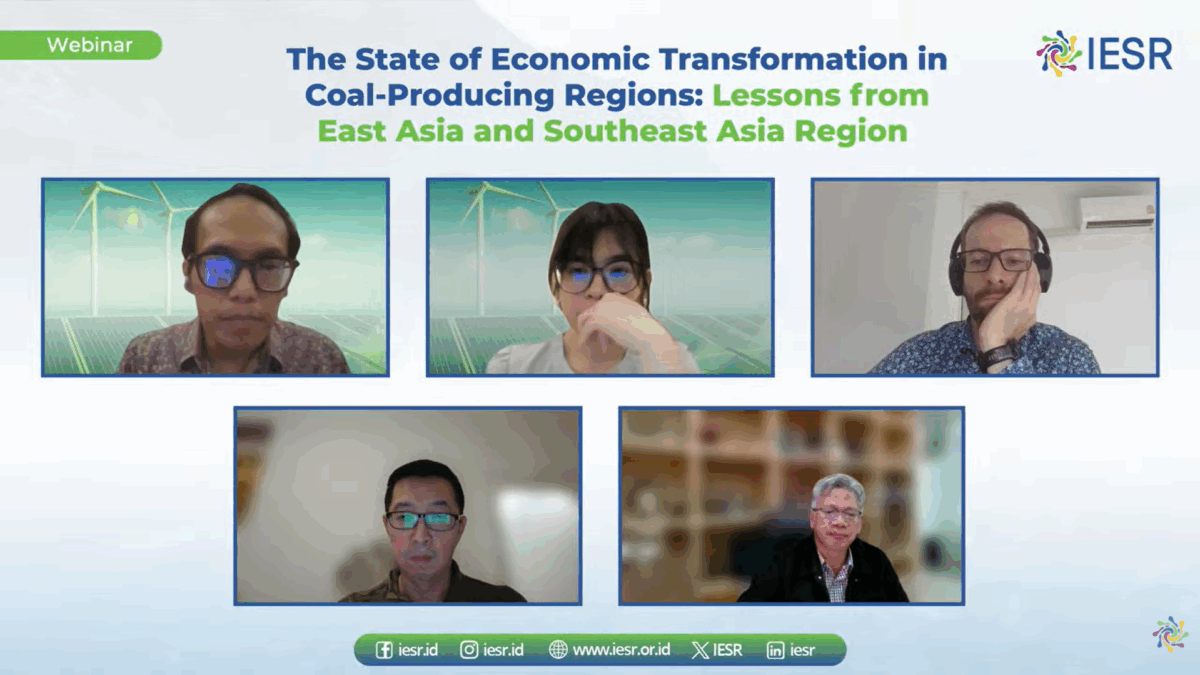Jakarta, November 13, 2025 – Although coal remains dominant and supports the economies of coal-producing countries like Indonesia, strengthening global climate commitments and decarbonization plans in destination countries for Indonesian coal exports, such as China, need to be anticipated.
Arief Rosadi, Climate and Energy Diplomacy Program Manager at the Institute for Essential Services Reform (IESR), explained in the webinar “The State of Economic Transformation in Coal-Producing Regions” that coal-producing regions are at a crossroads between the risks of a fossil fuel transition and vulnerability to climate impacts. Coal mining activities have made these provinces structurally dependent on coal economic activities.
“In the process of economic transformation, we can refer to the just transition framework to ensure that workers, communities, and local areas are not left behind in the process of economic transformation and reducing dependence on coal,” said Arief.
Arief added that the concept of a just transition has several key elements, such as economic diversification, skills retraining and social protection for workers, inclusive governance, policy and financial alignment, and environmental rehabilitation. Overall, a just transition must ensure that no one is left behind on the journey to a cleaner economy.
Martha Mendrofa, Coordinator of Social, Policy, and Economic Research at IESR, explained that the concept of a just transition is highly contextualized for Indonesia. Two provinces, East Kalimantan and South Sumatra, remain heavily dependent on the coal economy. However, the multiplier effect of coal mining activities is minimal for local people. The emerging economic activities are informal and unsustainable. The decline in coal demand will be felt from 2030 onward. This will impact the economic and social systems in coal-producing regions.
“We (IESR, ed.) recommend a definition of a just transition that encompasses a shift from a high-carbon socio-economic system through three approaches: economic transformation, social and political transformation, and environmental protection,” Martha said.
Stefan Bossner, Research Fellow at the Stockholm Environment Institute (SEI) Asia, added that economic transition and diversification plans must be supported by funding allocations, particularly for workers who will change sectors and require training.
“Provinces or regions dependent on coal require a well-thought-out economic transformation plan to gradually transition to a non-coal economy. In-depth analysis is crucial to determine new economic sectors,” said Stefan.
Stefan also emphasized the importance of involving local people in every aspect of this transition. Currently, at the grassroots level, few understand the global trend of coal phaseout and its impact on their lives.
Shanxi’s transformation strategy serves as a reflection. For seven decades (1949-2019), Shanxi Province was China’s largest coal producer. Raising awareness among the local community was a crucial element of Shanxi’s transition journey.
Tom Wang, Executive Director of People of Asia for Climate Solutions (PACS), stated that PACS conducted a survey of 9,000 people, of whom 3,000 worked in coal mines. Only 30-40 percent of respondents were prepared to switch jobs when the coal industry in Shanxi ceased operation.
“The main point of this survey is that they (residents) need to be prepared, and this applies not only to Shanxi but to all places that once relied on coal, such as Indonesia,” said Tom.
Tom continued, explaining that Shanxi is currently known for its advanced renewable energy industry. Whatever the new economic sector is developed, it must be planned and implemented now. China’s coal imports from January to October 2025 fell by 11% compared to last year. This is important for Indonesia to note, as China is a major export market for Indonesian coal.
Togu Pardede, Director of Energy and Mineral Resources at Bappenas (National Development Planning Agency), stated that the economic transformation of former mining areas is also a focus for Bappenas and is included in the National Medium-Term Development Plan (RPJMN). However, he acknowledged that his agency also requires strategic input from various parties for detailed planning at each location.
“Currently, we are focusing on planning and strengthening local communities for new economic resources. Therefore, we have begun opening vocational training institutions in former mining areas,” said Togu.

